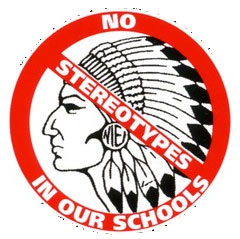The Nation regards the depiction of natives as mascots defamatory to our people. In brief, here are a few of the reasons why:
- Non-native peoples tend to view animals as beneath humans. Since most mascots are animals, people equivocate between teams and their mascots. Their mascot is just as good as the next. Or our mascot is better than your mascot and therefore you have the belief that the Bears are superior to the Indians.
- Mascots tend to suspend natives in time. When our white brothers first entered the land, they saw the young Onondaga men as fierce, bold, tough, and dressed in animal skins. Today, young Onondaga men and women have intricate and beautiful regalia worn for the Creator and also modern clothing worn to suit going to high school, college and earning a living.

- Mascots are stereotypical. In trying to understand a different culture of people of various languages, government, and clothing, native people were lumped into one generic figure that could be identified as “Indian.” Therefore mascots are usually not representative of the Haudenosaunee people.
- Fighting and skin color is not our only positive trait. Although it is true that Onondaga and its Haudenosaunee allies have proven themselves in battle, there are other gifts that we are thankful for. Onondagas honor and foster many other traits such as diplomacy, artisans, educators, agriculturists, hunters, musicians, architects, and philosophers to name a few. The Creator gives us all a special gift and it is the combination of all these gifts that make us the complex diverse nation of people we are today.
- Natives are the only race depicted as mascots. Society has recognized the inappropriateness of cultures being made into caricatures, put on helmets, t-shirts and bumper stickers. The fact that schools and organizations have “always” been the Braves, Chiefs, Red Men, Redskins, Warriors, or Indians, does not give the community the right to defame a culture.
- The Onondaga Nation Council of Chiefs has long held the belief that mascots are offensive. In 1970, the chiefs met with Syracuse University about the Saltine Warrior mascot. The chiefs recognized the responsibility of the University to be culturally respectful. The depiction of an Indian running around in leather and a Sioux war bonnet was not only incorrect, but offensive. The chiefs explained that there was no dignity within the native community when the Saltine Warrior meets and jousts with wildcats, hogs, bulldogs in front of thousands of people. After a year of negations, the Chancellor agreed with the Onondaga leaders that the Saltine Warrior mascot was offensive and was removed.
- Mascots are not viewed as an honor. Many organizations hold the belief that these mascots bring pride to our community, they do not. Often individuals ‘dress up’ like their mascot and act in ways which are not very honorable. It would be more honorable if communities supported their elected officials to meet with Native nations in a government-to-government manner.
